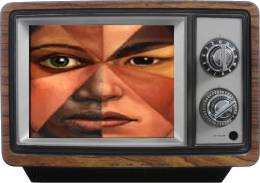|
|
Racial and Racist
|
|
Not all stereotyping is bad. Stereotyping arises out of the need to generalize in order to make sense out of a very complicated environment. It allows people to easily categorize new things into comfortable spaces already defined by their experiences. This process was described in 1922 by Walter Lippmann, who first coined the term "stereotyping." Lipmann wrote, "the attempt to see all things freshly and in detail, rather than as types and generalities, is exhausting, and ... practically out of the question." Societies construct hierarchies of value and power so that some races are perceived to be more dominant and others are subordinate. We sort people into different races based on genetic traits: skin color, hair color and texture, and facial features. What these different racial categories mean to us is a product of social collaboration. We are conditioned to believe that people are defined by race and so we draw boundaries between the various races and police those boundaries. Ethnicity, like race, is socially constructed. Ethnicity incorporates race, but expands beyond it to include religion, nationality, heritage, and cultural practices. A single racial group may consist of dozens of ethnicities. As with racial groups, some ethnicities are culturally valued while others are devalued. Negative stereotyping arises out of an ethnocentric view of the world; ones own group is the standard by which all others are judged. Negative stereotypes are prejudicial judgments that assign negative qualities to other groups. Repeated exposure to negative stereotypes causes those who are being stereotyped to internalize the stereotypes. This internalization damages character by causing low self-esteem, low expectations, low motivation, self-doubt, etc. And in turn this damage contributes to a host of bad outcomes, such as high unemployment, poor marriage success, low educational achievement, and criminality. Through this process, negative stereotypes can become a self-fulfilling prophecy. Repetition tends to normalize stereotypes, because repeating stereotypes validates and perpetuates them. Because stereotypes often contain a "kernel of truth" (they may be characteristic of some or many members of a group) they are widely accepted as the truth. However, specific tendencies that may be widespread among a group should never be applied to every member of a group. That's because the stereotypes generalize individuals within a group, emphasizing sameness and ignoring individual variety. The repetition of racist stereotypes can be used to justify actions that would normally be unimaginable, as was the case with Germany during World War Two. Hitler's anti-Semitism could never have precipitated the Holocaust if Germans didn't already have a long history of anti-Semitic beliefs and actions. The repetition of negative racial stereotypes about Jews and other so-called "undesirables" ultimately propelled ordinary Germans to systematically kill millions of innocent men, women and children. Negative racial stereotyping was used by all sides during the Second World War to demonize enemies. Racist stereotypes were also used to justify a steady stream of civilian deaths and crimes against humanity, and the United States was certainly no exception. The firebombing of Dresden and Tokyo as well as the atomic bombs that were dropped on Japan caused human slaughter on a massive scale. Ordinary Americans believed these actions were justified because of the negative stereotyping of America's enemies that preceded the war, and the more virulent forms that emerged during the war. The media uses stereotypes as a shorthand method of
defining characters in ways that are easy for people to identify and
categorize. What these stereotypes all have in common is that they reduce to a one-sided, superficial and exaggerated depiction the real variety,
depth and complexity of a people. The media today is more sensitive to issues of culture and gender than it once was, but
the creation and perpetuation of common misconceptions about groups of people
continues. Oversimplified and inaccurate portrayals have profoundly affected how we perceive one another, how we relate to one another and how we value ourselves. |
|


